

How to buy and store ginger
Ginger can be bought in many forms, fresh or dried, ground, preserved or pickled.
Fresh ginger can be found in your local produce store or supermarket. This is the ideal way to buy ginger as the fresh rhizome provides the best flavour and higher levels of the gingerols that contains all the health benefits. Make sure when buying fresh ginger it is firm to touch, smooth on the skin with no signs of brown rot on the end and no sign of dehydration.
Fresh ginger should always be peeled before use.
Store your fresh ginger at 13-15C. A good place is at the bottom of the refrigerator in the crisper or in a dark area of a cool cupboard. The older the ginger the longer it will last. Young or new season ginger will be usable for around three weeks but mature or old season ginger may last for many months.
Ginger, a short history
Ginger is thought to have originated in the tropical jungles of Southern Asia, probably on the Indian subcontinent. The ginger plant was cultivated there and in China long before its use was recorded.
More than 2000 years ago, ginger was brought from India to the Middle East and from there Arab traders sold it to both the Greeks and the Romans. Records show that ancient Rome taxed ginger when it came ashore at Alexandria. Around the 11th century, Europe rediscovered ginger. By the 14th century, the only spice more popular than ginger was black pepper. It is believed Queen Elizabeth I (1533-1603) was fond of ginger. She is given the credit for the appearance of the now famous gingerbread men.
As Western Europeans fanned out across the globe, ginger went with them. It is now grown in tropical countries around the world with China and India still the largest exporters. But it is said the world’s finest ginger is grown in Australia and Australian ginger is used in the manufacture of some of Europe’s most exclusive confectionery.
The ginger plant
Ginger is closely related to turmeric and cardamom. Its Latin name is Zingiber officinale. The ginger plant itself is a perennial that grows from 30-90cms in height. Its lush green spears sprout from thick underground rhizomes, which are not roots but actually the under-ground portion of the individual spears. Ginger reproduces by sending out shoots from the original plant and these rhizomes then send up more shoots, to produce new ginger plants.
The ginger rhizome changes colour as it ages.
Young or New Season ginger has a white juicy flesh with a milder taste. Due to the softness of the rhizome the shelf life is shorter, so it is better to use it as soon as possible.
Mature or Old Season ginger has a golden brown flesh. The older the ginger, the longer it will last and the ‘hotter’ it will taste.
The medicinal benefits of ginger:
For almost 6000 years, people in China and India have regarded ginger as a universal cure-all. Even today, it is a component in about half of the traditional Chinese and herbal remedies. One of the earliest medical books in China, written about 2000 BC and several ancient Indian texts written in the 3rd or 4th century AD, all discuss treatments using ginger.
The wonderful flavour and scent of ginger come from the oils zingerone, gingerols and shogoals. There is a considerable amount of research that shows these oils in ginger can be effective as:
- an aid to digestion,
- relief for nausea and morning sickness
- help in the relief of inflammation and pain.
- preventative and reliever of motion sickness.
And more recently
- Manage high levels of blood sugar for Diabetics.
Ginger is also said to speed up the metabolism and thus to burn fat. And ginger tea is said to help ease headache and sore throats and give some relief to sufferers of colds and flu.
Templeton Ginger
